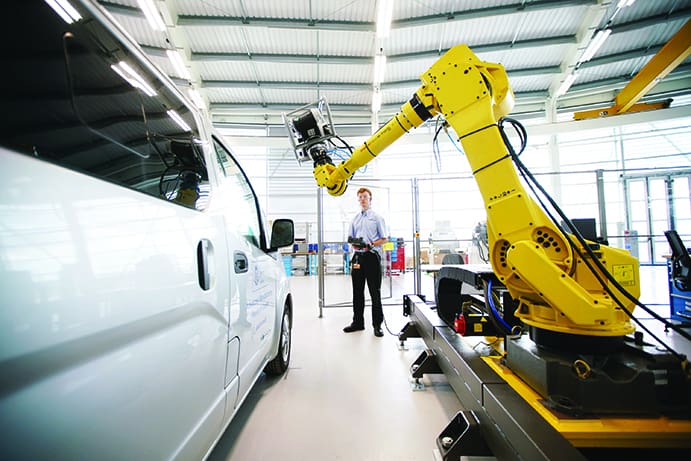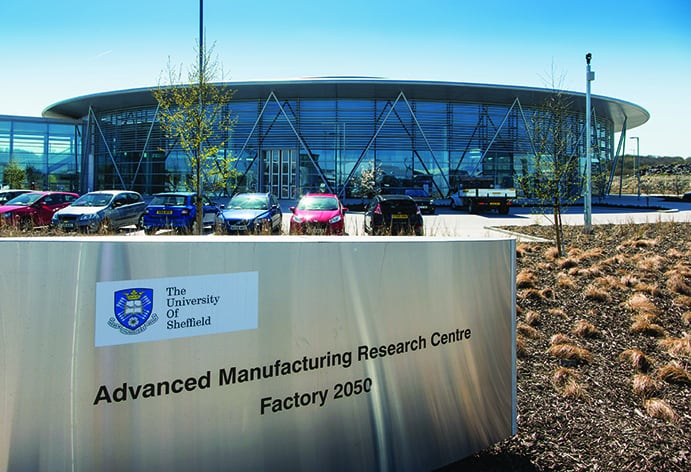The AMRC Factory 2050 facility is helping to put the UK at the forefront of manufacturing technology research and development
On the eastern edge of Sheffield, where the city merges into its neighbour Rotherham, a spectacular looking circular building with an almost entirely glazed exterior is the latest addition to one of the UK’s leading sites for research and development of manufacturing technologies. The structure is the Factory 2050 facility, which started up late in 2015 as part of the Advanced Manufacturing Research Centre (AMRC) – a joint initiative of the University of Sheffield and US aerospace giant Boeing – that has operated over the wider immediate area since just after the turn of the millennium.

According to Stuart Dawson, chief technology officer for the AMRC, some 500 people are now employed across the site, generating an annual turnover of around £32m. Activities range across several different application areas, including nuclear, castings and composites, but in all cases the basic methodology is that of cooperative technology development projects between the AMRC’s own personnel and industrial partners. In the case of the new Factory 2050 building, the emphasis, as the name indicates, is to explore the technologies that could form the basis of manufacturing over the coming decades. Four in particular, says Dawson, form the current focus of work there:
- Robotics and automation
- Integrated large-volume metrology
- Digitally assisted assembly
- Manufacturing informatics
The evidence is to be found most tangibly in a series of cells occupied by robotic and other hardware, where much of the work takes place. Dawson makes the point only half jestingly that though project details are often confidential, the fact that the physical activities involved are literally open to view is quite deliberate – apart from its practical contribution to real manufacturing now the whole facility is also intended to act as a showcase to stimulate interest in manufacturing technology, particularly among younger people. They would, he says, be welcome to “press their noses against the windows”.
Nevertheless, the work that takes place in the Factory 2050 building is a continuation of previous operations carried out by the AMRC’s Integrated Manufacturing Group (IMG), which now comprises over 60 engineers boasting a noticeably wide range of individual skillsets, including mechanical, control, electronics and even some derived from the world of video gaming. That team is headed by Ben Morgan, who joined the AMRC as a graduate nine years ago and who says the breadth of skills it embodies is a key reason why it can work just as easily with small SMEs or massive multi-national companies. Indeed, he adds, factor in the way that the IMG can tap into a wider range of resources such as those at its parent university, and the whole operation boasts a depth of expertise “that even big multi-nationals sometimes cannot match”.
But, Morgan continues, projects do not necessarily need to include intensive research and development work. Instead they may sometimes comprise just a few weeks of consultation. He says around 60 separate initiatives involving the IMG and client companies are currently underway.
Robotic manufacturing
One project that definitely stands at the high end of the spectrum – whether the benchmark is that of the technical challenge involved or simply money saved for the client company – is represented by a robotic manufacturing cell that stands in an annexe to the main Factory 2050 building. Morgan confirms the cell in Sheffield is an exact replica of one that is now in operation at the BAE Systems plant in Salmesbury, across the Pennines in Lancashire, where it is used to drill to highly exacting tolerances the countersinks in carbon fibre composite wing skins of F35 aircraft through which fasteners are inserted to join the skins to the aircraft frames. Getting the process right is crucial to the performance of the plane – drill the holes too wide so that the head of a fastener goes below the wing surface and aerodynamic performance is impaired, drill them too narrow so that the fastener stands fractionally proud and anti-radar stealth capability is reduced.
The project that enabled that aspiration to become reality took three years before the cell went into operation in 2015. But, as Morgan is keen to stress, the replica at Factory 2050 remains a working installation used for continuing development work. That way, he explains, BAE can avoid the downtime that might result from debugging enhancements to the system on its own shopfloor and can instead implement them in a seamlessly and reliably rapid manner.
This highly automated approach is in stark contrast to the previous methodology employed for the task by BAE which was, Morgan confirms, entirely manual. Moreover, that way of doing things was “extremely strenuous” for the workers, with a high rate of repetitive strain injuries. Furthermore, with BAE looking to ramp up to a production rate of an aircraft every couple of days, that way of proceeding was also unacceptably slow.

But, Morgan further explains, though existing automated manufacturing technologies were capable of satisfying both the required accuracy and speed requirements, the necessary capital outlay would have been daunting. BAE would have required probably half-a-dozen specialised CNC milling machines so that the total investment would have been “tens of millions of pounds”.
Work at Sheffield did not, however, start from scratch. Morgan says when the team there took on the project, BAE had already worked with robot supplier Kuka to develop a concept that he describes as at “level four – proven in principle” of the one to nine hierarchy in which seven would indicate ready for implementation and nine proven in practice.
As such the work required to progress the cell from the first to the second of those levels involved aspects of both programming and mechanical design intended to make robots – a type of device that he observes is typically associated with the comparatively less demanding world of automotive manufacturing – compatible with the extreme demands of military aerospace. Morgan says the crucial parameters were those of accuracy and stiffness and that a key aspect of the final cell configuration that achieved the necessary performance goals was the use of two robots – one behind the work piece to hold it in place and one in front to carry out the hole drilling.
Wing-skin variants
But literal stiffness has also been combined with metaphorical flexibility. As Morgan further explains, BAE manufactures 60 different wing-skin variants in total and so another key attribute of the system developed by the AMRC is that it has avoided any requirement for hard, bespoke fixturing for each variant. Instead, the technique of augmented reality has been utilised to provide computer-generated visual guidance for operators to support them in configuring the cell accurately and reliably for the manufacture of particular variants.
“We used optical projection a bit like you get in a boardroom,” he notes. “The key thing with automation is that to get a consistent output you need a consistent input so we needed a robust process to ensure that the position of the part is the same each time.”
Moreover, Morgan adds, the sheer speed of the drilling operation itself has been reduced “from 55 seconds per hole to under 20 seconds”. Given that several thousand such operations are required for each aircraft, the time savings the new cell achieves are self-evident. Continuing work on the cell, he says, is focusing on using the Industry 4.0 concept to enable closed-loop feedback of sensor data to optimise the procedures while they are underway.
2018 will also see two further notable additions to the AMRC site. One will be a manufacturing facility for UK super-car manufacturer McLaren, where it will make the composite safety tubs that provide impact protection for drivers. The other, due to open, according Stuart Dawson, in “Q3-Q4”, will arguably be even more significant – the first-ever directly-owned manufacturing facility outside the US for Boeing, where it will produce parts for landing gear actuators.










Comment: The UK is closer to deindustrialisation than reindustrialisation
"..have been years in the making" and are embedded in the actors - thus making it difficult for UK industry to move on and develop and apply...